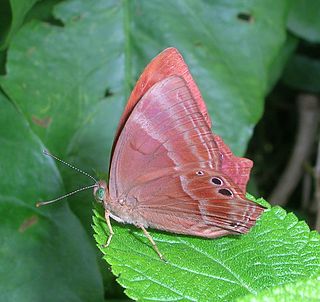
Abisara echerius, the plum Judy, is a small but striking butterfly found in Asia belonging to the Punches and Judies family (Riodinidae). It is difficult to distinguish it from Abisara bifasciata.

Teinopalpus imperialis, the Kaisar-i-Hind, is a rare species of swallowtail butterfly found from Nepal and north east India to north Vietnam. The common name literally means "emperor of India". The Kaisar-i-Hind is much sought after by butterfly collectors for its beauty and rarity. The green iridescence of the wings has been found to be due to three-dimensional photonic structure of the scales and is the subject of much research.

Graphium mandarinus, the spectacle swordtail, which is native to India, is a butterfly of the swallowtail family (Papilionidae). It belongs to subgenus Pazala of the swordtails, that is, genus Graphium.
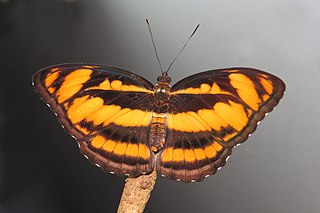
Athyma nefte, the colour sergeant, is a species of brush-footed butterfly found in tropical South and Southeast Asia.

Cethosia nietneri, the Tamil lacewing, is a species of nymphalid butterfly found in Sri Lanka and south India. The species name is after John Nietner who obtained specimens of the butterfly from Ceylon from which it was described.
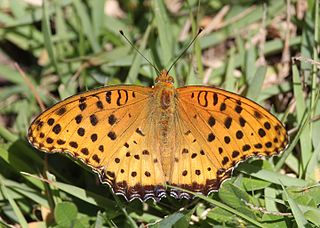
The Indian fritillary is a species of butterfly of the nymphalid or brush-footed family. It is usually found from south and southeast Asia to Australia.

Eudocima phalonia, the common fruit-piercing moth, is a fruit piercing moth of the family Erebidae. The species was first described by Carl Linnaeus in his 1763 Centuria Insectorum. It is found in large parts of the tropics, mainly in Asia, Africa and Australia but introduced into other areas such as Hawaii, New Zealand and the Society Islands. It is one of major fruit pests in the world.
Acroncosa albiflavella is a species of moth of the family Pyralidae, of the order Lepidoptera. Acroncosa albiflavella was described by William Barnes and James Halliday McDunnough in 1917. It is found in western North America, including New Mexico and California.
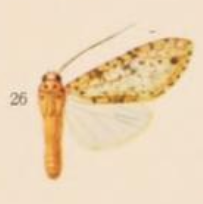
Lophocampa endrolepia is a moth of the family Erebidae. It was described by Paul Dognin in 1908. It is found in Ecuador.

Spilosoma ignivagans is a moth in the family Erebidae. It was described by Rothschild in 1919. It is found in China (Yunnan).
Ambia chalcichroalis is a moth in the family Crambidae. It was described by George Hampson in 1906. It is found in South Africa.
Syllepte melanomma is a moth in the family Crambidae. It was described by George Hampson in 1912. It is found in Nigeria.
Ambia vagilinealis is a moth in the family Crambidae. It is found in Papua New Guinea.
Jana aurivilliusi is a moth in the family Eupterotidae. It was described by Rothschild in 1917. It is found in Nigeria.
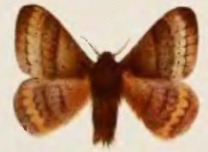
Cotana brunnescens is a moth in the family Eupterotidae. It was described by Walter Rothschild in 1917. It is found in New Guinea.

Cotana variegata is a moth in the family Eupterotidae. It was described by Walter Rothschild in 1917. It is found in New Guinea.
Tantaliana nigristriata is a moth in the family Eupterotidae. It was described by Anthonie Johannes Theodorus Janse in 1915. It is found in South Africa, where it has been recorded from Mpumalanga and KwaZulu-Natal.
Hemijana variegata is a moth in the family Eupterotidae. It was described by Rothschild in 1917. It is found in Mozambique.
Striginiana pseudostrigina is a moth in the family Eupterotidae. It was described by Rothschild in 1917. It is found in the Democratic Republic of Congo.
Battaristis coniosema is a moth of the family Gelechiidae. It was described by Edward Meyrick in 1922. It is found in Peru and Pará, Brazil.










